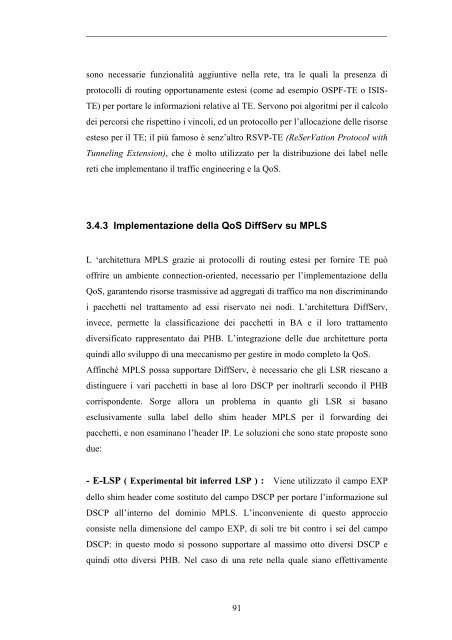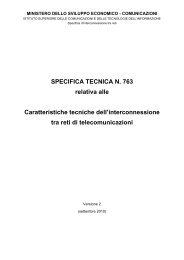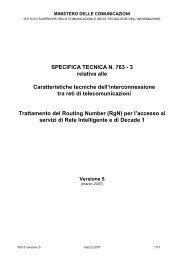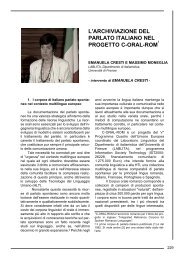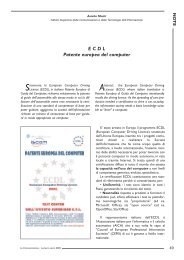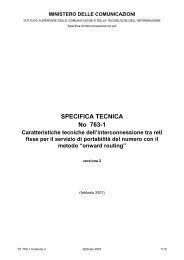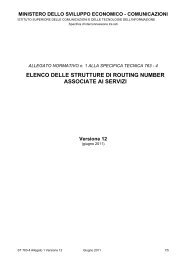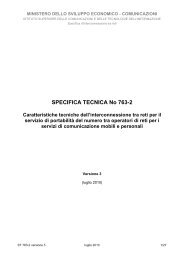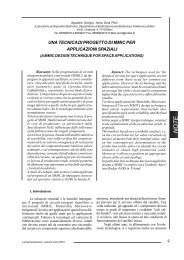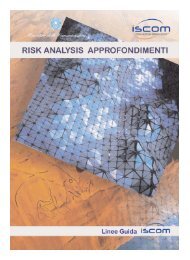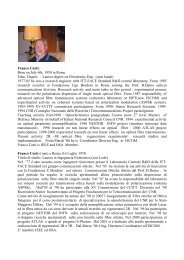Test bed per la valutazione della Qualità del Servizio in reti ottiche ...
Test bed per la valutazione della Qualità del Servizio in reti ottiche ...
Test bed per la valutazione della Qualità del Servizio in reti ottiche ...
You also want an ePaper? Increase the reach of your titles
YUMPU automatically turns print PDFs into web optimized ePapers that Google loves.
__________________________________________________________________<br />
sono necessarie funzionalità aggiuntive nel<strong>la</strong> rete, tra le quali <strong>la</strong> presenza di<br />
protocolli di rout<strong>in</strong>g opportunamente estesi (come ad esempio OSPF-TE o ISIS-<br />
TE) <strong>per</strong> portare le <strong>in</strong>formazioni re<strong>la</strong>tive al TE. Servono poi algoritmi <strong>per</strong> il calcolo<br />
dei <strong>per</strong>corsi che rispett<strong>in</strong>o i v<strong>in</strong>coli, ed un protocollo <strong>per</strong> l’allocazione <strong>del</strong>le risorse<br />
esteso <strong>per</strong> il TE; il più famoso è senz’altro RSVP-TE (ReSerVation Protocol with<br />
Tunnel<strong>in</strong>g Extension), che è molto utilizzato <strong>per</strong> <strong>la</strong> distribuzione dei <strong>la</strong>bel nelle<br />
<strong>reti</strong> che implementano il traffic eng<strong>in</strong>eer<strong>in</strong>g e <strong>la</strong> QoS.<br />
3.4.3 Implementazione <strong>del</strong><strong>la</strong> QoS DiffServ su MPLS<br />
L ‘architettura MPLS grazie ai protocolli di rout<strong>in</strong>g estesi <strong>per</strong> fornire TE può<br />
offrire un ambiente connection-oriented, necessario <strong>per</strong> l’implementazione <strong>del</strong><strong>la</strong><br />
QoS, garantendo risorse trasmissive ad aggregati di traffico ma non discrim<strong>in</strong>ando<br />
i pacchetti nel trattamento ad essi riservato nei nodi. L’architettura DiffServ,<br />
<strong>in</strong>vece, <strong>per</strong>mette <strong>la</strong> c<strong>la</strong>ssificazione dei pacchetti <strong>in</strong> BA e il loro trattamento<br />
diversificato rappresentato dai PHB. L’<strong>in</strong>tegrazione <strong>del</strong>le due architetture porta<br />
qu<strong>in</strong>di allo sviluppo di una meccanismo <strong>per</strong> gestire <strong>in</strong> modo completo <strong>la</strong> QoS.<br />
Aff<strong>in</strong>ché MPLS possa supportare DiffServ, è necessario che gli LSR riescano a<br />
dist<strong>in</strong>guere i vari pacchetti <strong>in</strong> base al loro DSCP <strong>per</strong> <strong>in</strong>oltrarli secondo il PHB<br />
corrispondente. Sorge allora un problema <strong>in</strong> quanto gli LSR si basano<br />
esclusivamente sul<strong>la</strong> <strong>la</strong>bel <strong>del</strong>lo shim header MPLS <strong>per</strong> il forward<strong>in</strong>g dei<br />
pacchetti, e non esam<strong>in</strong>ano l’header IP. Le soluzioni che sono state proposte sono<br />
due:<br />
- E-LSP ( Ex<strong>per</strong>imental bit <strong>in</strong>ferred LSP ) : Viene utilizzato il campo EXP<br />
<strong>del</strong>lo shim header come sostituto <strong>del</strong> campo DSCP <strong>per</strong> portare l’<strong>in</strong>formazione sul<br />
DSCP all’<strong>in</strong>terno <strong>del</strong> dom<strong>in</strong>io MPLS. L’<strong>in</strong>conveniente di questo approccio<br />
consiste nel<strong>la</strong> dimensione <strong>del</strong> campo EXP, di soli tre bit contro i sei <strong>del</strong> campo<br />
DSCP: <strong>in</strong> questo modo si possono supportare al massimo otto diversi DSCP e<br />
qu<strong>in</strong>di otto diversi PHB. Nel caso di una rete nel<strong>la</strong> quale siano effettivamente<br />
91


